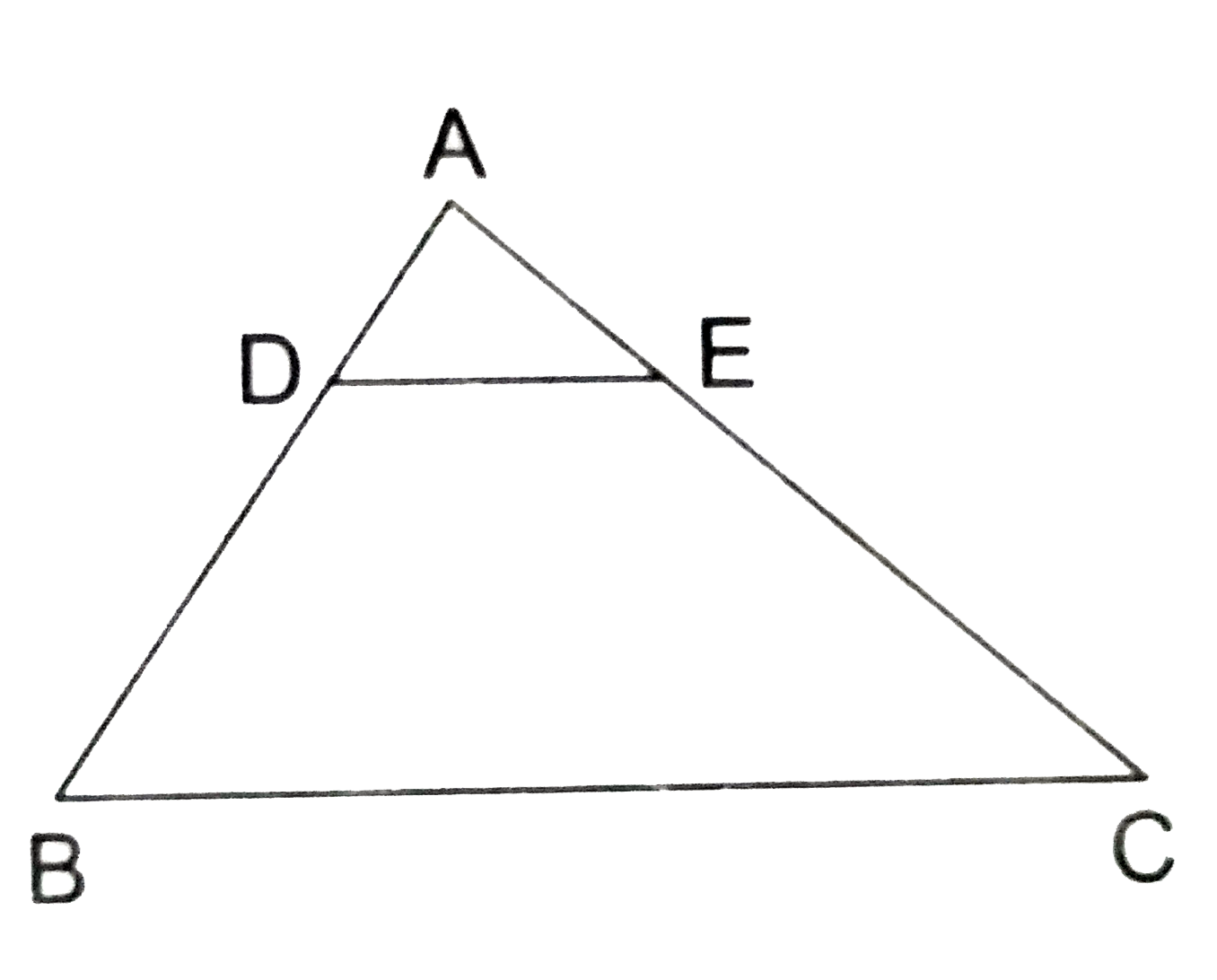P and Q are points on the sides AB and AC respectively of a △ABC. If AP= 2cm, PB = 4cm AQ= 3cm and QC= 6cm. Show that BC= 3PQ.
To solve the problem, we need to show that BC=3PQ given the points P and Q on the sides AB and AC of triangle ABC.
1. Identify the lengths:
- Given AP=2 cm, PB=4 cm, AQ=3 cm, and QC=6 cm.
- First, we find the total lengths of sides AB and AC:
AB=AP+PB=2+4=6 cm
AC=AQ+QC=3+6=9 cm
2. Establish similarity of triangles:
- We note that triangles ABC and APQ share angle A (common angle).
- Additionally, angles ∠ABC and ∠APQ are equal (corresponding angles) because P and Q lie on the sides AB and AC respectively.
3. Write the similarity ratio:
- Since triangles ABC and APQ are similar, we have:
ABAC=PQBC
4. Substituting the known lengths:
- We substitute the lengths we calculated:
69=PQBC
5. Simplifying the ratio:
- The left side simplifies to:
23=PQBC
6. Cross-multiplying to find BC:
- Cross-multiplying gives:
2⋅BC=3⋅PQ
- Rearranging this equation gives:
BC=32PQ
7. Final adjustment:
- To express BC in terms of PQ, we can multiply both sides by 32:
BC=3⋅PQ
Conclusion:
Thus, we have shown that BC=3PQ.
- Given AP=2 cm, PB=4 cm, AQ=3 cm, and QC=6 cm.
- First, we find the total lengths of sides AB and AC:
AB=AP+PB=2+4=6 cm
AC=AQ+QC=3+6=9 cm
- We note that triangles ABC and APQ share angle A (common angle).
- Additionally, angles ∠ABC and ∠APQ are equal (corresponding angles) because P and Q lie on the sides AB and AC respectively.
- Since triangles ABC and APQ are similar, we have:
ABAC=PQBC
- We substitute the lengths we calculated:
69=PQBC
- The left side simplifies to:
23=PQBC
- Cross-multiplying gives:
2⋅BC=3⋅PQ
- Rearranging this equation gives:
BC=32PQ
- To express BC in terms of PQ, we can multiply both sides by 32:
BC=3⋅PQ
Thus, we have shown that BC=3PQ.
Topper's Solved these Questions
- BOOK - NAGEEN PRAKASHANCHAPTER - TRIANGLES EXERCISE - Exercise 6c11videos
TRIANGLES
- BOOK - NAGEEN PRAKASHANCHAPTER - TRIANGLES EXERCISE - Exercise 6d24videos
TRIANGLES
- BOOK - NAGEEN PRAKASHANCHAPTER - TRIANGLES EXERCISE - Eercise 6b1videos
TRIANGLES
- BOOK - NAGEEN PRAKASHANCHAPTER - STATISTICS EXERCISE - Revision Exercise Long Answer Questions5videos
STATISTICS
- BOOK - NAGEEN PRAKASHANCHAPTER - VOLUME AND SURFACE AREA OF SOLIDSEXERCISE - Revisions Exercise Long Answer Questions5videos
VOLUME AND SURFACE AREA OF SOLIDS
Similar Questions
Knowledge Check
- Question 1 - Select One
In ΔABC D and E are the points on sides AB and AC, respectively, such that DE || BC. If AD = 4 cm, BC = 5 cm. DC = 10 cm and AB = 15 cm. then the sum of the lengths of DE and EC is:
AA. 20 cmBB. 15 cmCC. 21 cmDD. 18 cm
In ABC , P and Q are points on sides AB and AC respectively such that PQBC . If AP=3cm , PB=5cm and AC=8cm , find AQ .
View SolutionIf D and E are points on the sides AB and AC respectively of DetlaABC such that AB=5.6cm,AD=1.4cm,AC=7.2cmandAE=1.8cm. Show that DE∣∣BC.
 View Solution
View SolutionD and E are the points on the sides AB and AC respectively of a ABC such that: AD=8cm, DB=12cm, AE=6cm and CE=9cm . Prove that BC=5/2 DE .
View SolutionIn ΔABC,D and E are points on the sides AB and AC respectively ,such that DE||BC. If AD=2.5cm,BD=3cm and AE =3.75 cm , then the value of AC.
View Solutionif D and E are points on the sides AB and AC of a ΔABC. Such that AB=12 cm, AD=8 cm, AE=12 cm, AC= 18 cm. show that DE||BC.
View SolutionD and E are points on the sides AB and AC respectively of a △ABC such that DE||BC
(i) If AD=3.6cm,AB=10cm and AE=4.5cm, find EC and AC .
(ii) If AB=13.3cm,AC=11.9cm and EC=5.1cm," find AD
(iii) If ADDB=47 and AC=6.6cm find AE
(iv) If ADAB=815 and EC=3.5cm find AEView SolutionIn a triangle ABC, P and Q are points on AB and AC, respectively, such that AP=1 cm, PB=3 cm, AQ=1.5 cm, and CQ=4.5 cm. If the area of △APQ is 12cm2, then find the area of BPQC
 View Solution
View Solution

